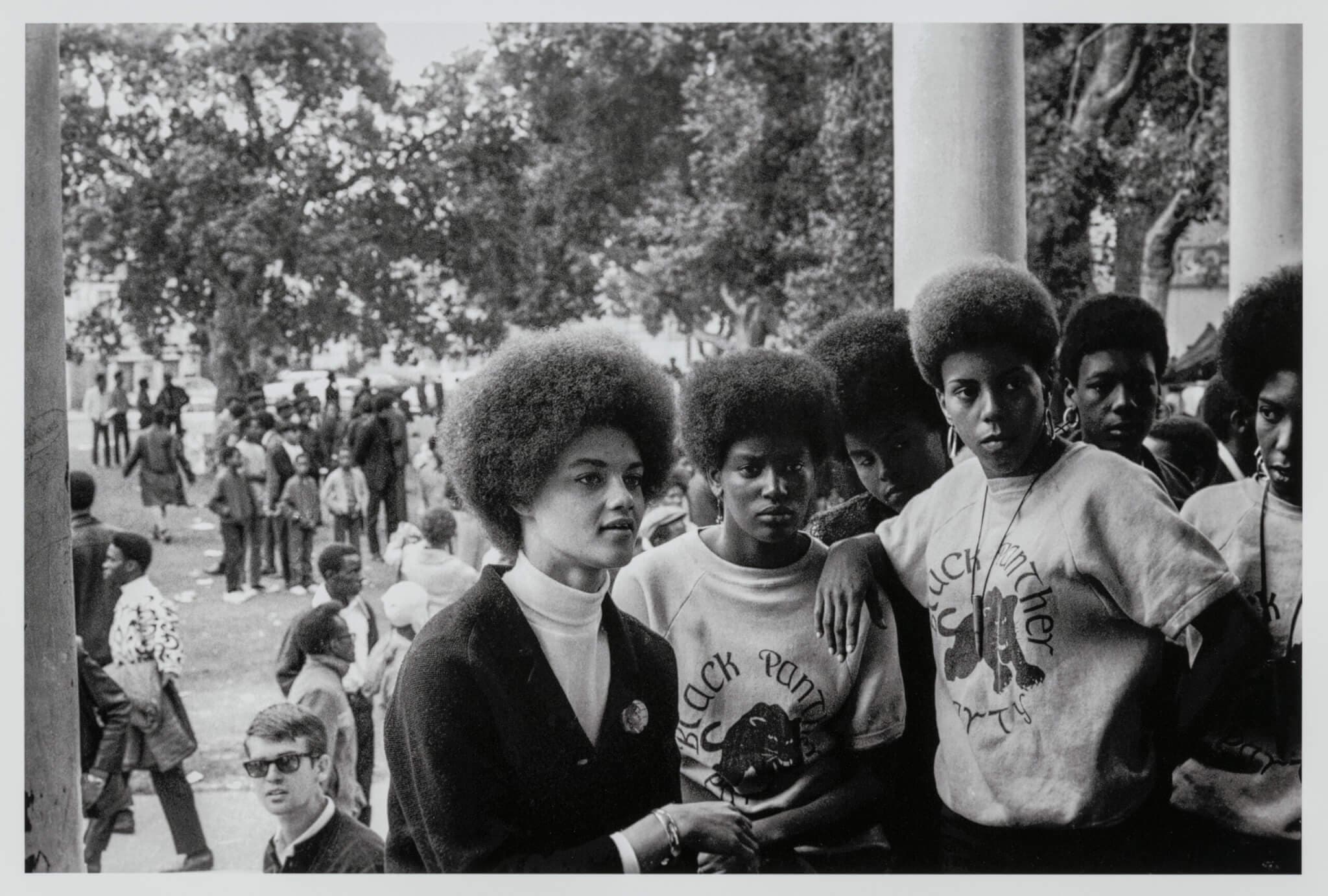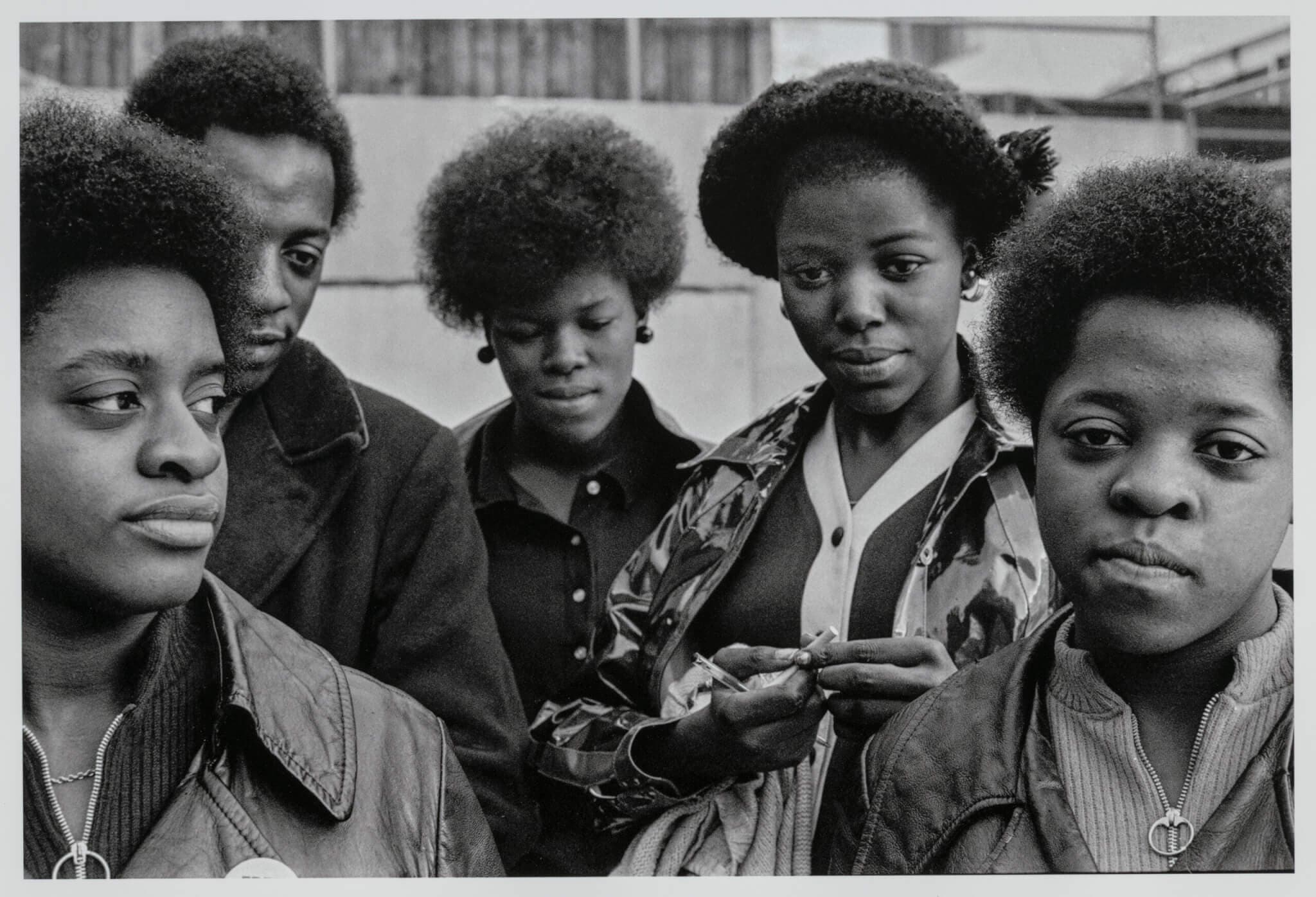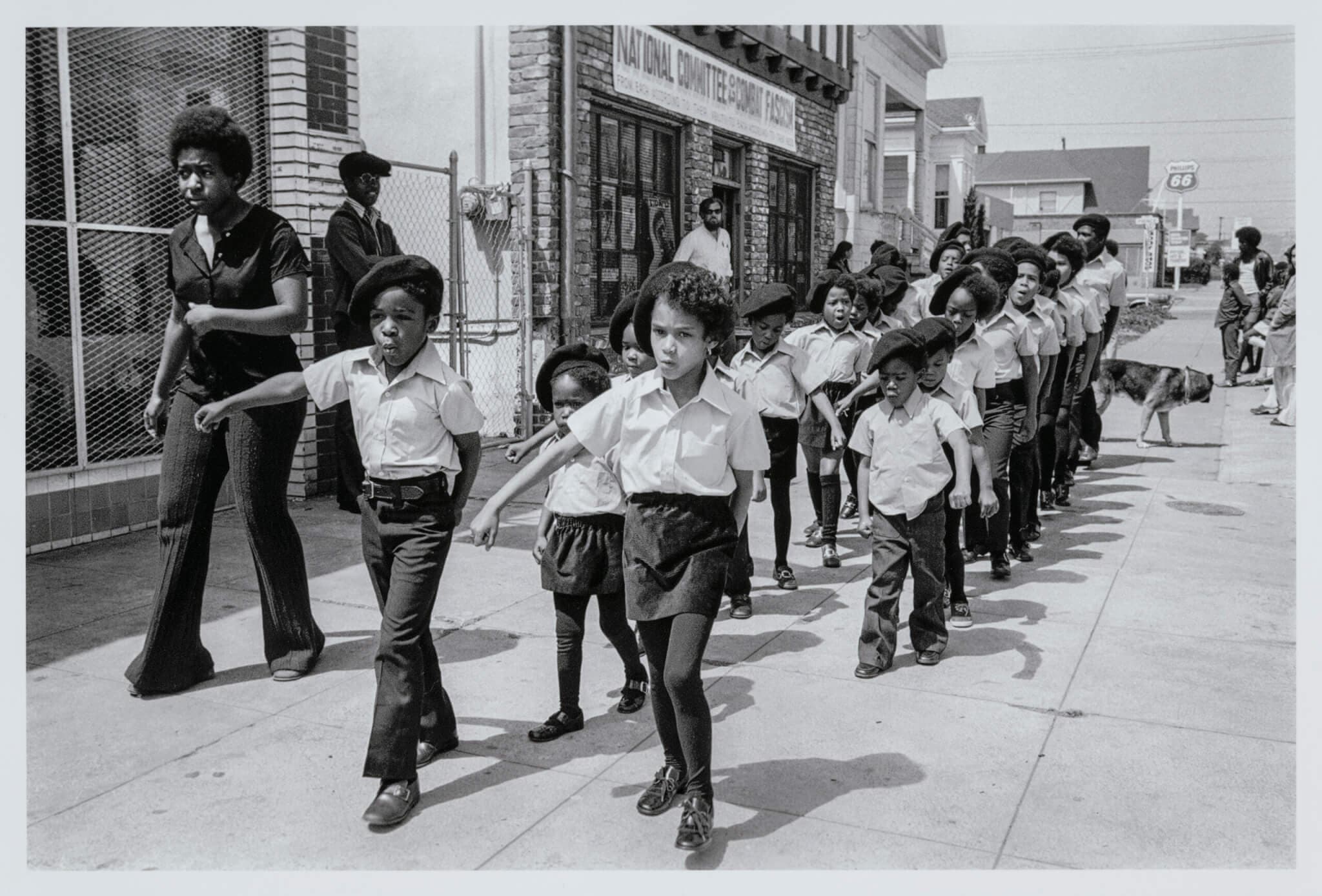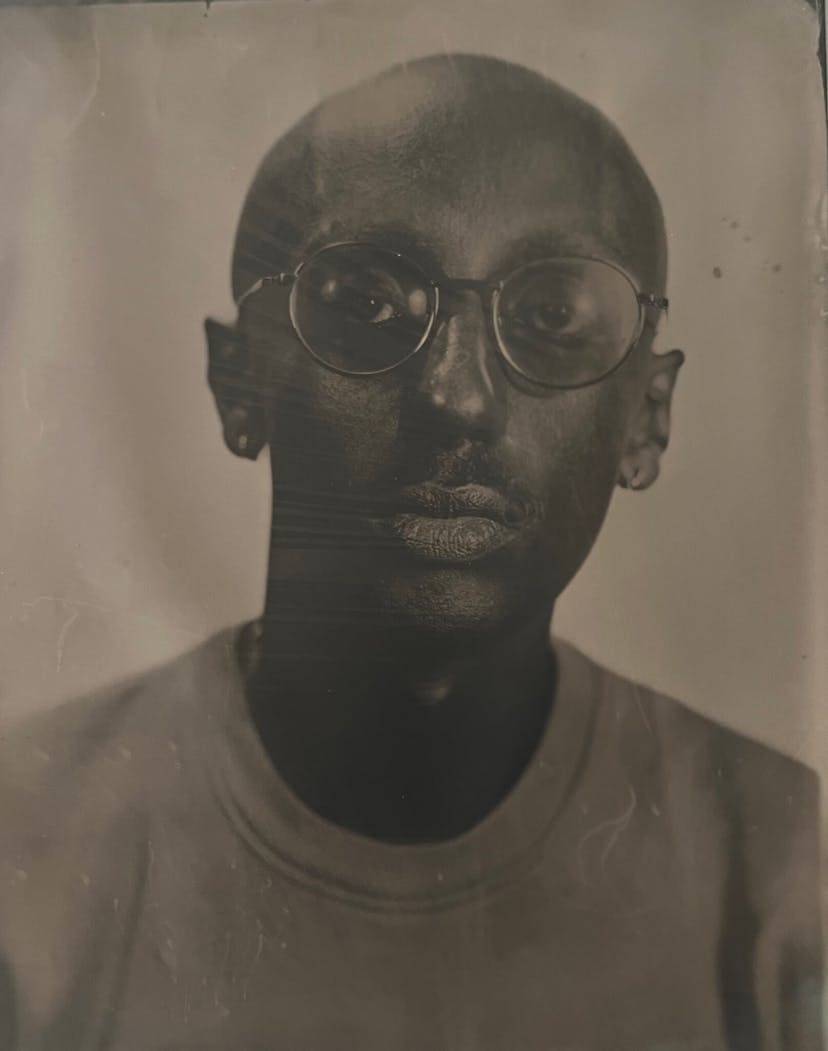Past the coat check, the first rotunda, and the visitor’s desk, mere steps into the second roundabout greeting visitors at the MFA, a photographic window into movement organizing history opened. “Comrade Sisters: Women of the Black Panther Party” arrived at the MFA in December 2023 and closed on June 24 of this year; the exhibition was an undertaking of the Black non-male experience in the Black Panther struggle from coast to coast, and an attempt at documenting the Panthers’ legacy in community organizing. Now that the images have returned to the MFA’s private collection—as have many artifacts of Black movements housed at historically white/elite museums—the opportunities and limitations of an exhibition like “Comrade Sisters” remain points of concern for present-day community organizers and interlocutors.
The exhibition was a gift from Lizbeth and George Krupp (of the Krupp Family Foundation), and consisted of twenty-seven black-and-white photographs (1) taken by Cambridge-born and California-raised photojournalist Stephen Shames, the National Black Panther Party’s official photographer from 1968 to 1973 (2). Black female faces in print greeted viewers with steely gazes and warm-eyed smiles, inquisitive or goofy looks darting across serious scenes that specified the humanity embedded even in militancy through the exhibition’s emphasis on group and solo portraiture and on moments of calm congregation.
The Black Panther Party’s contentious relationship to gender liberation necessitated the exhibition’s woman-centered story. The Party has been described at times as an incarnation of “Black Macho” politics, placing Black male interests first and subjecting women of the party to subservience. Following the chorus of Black feminist voices who rejected this characterization (3), “Comrade Sisters” emphasized the centrality of female players and organizers as leaders and stewards of the party—fitting given the Party’s overwhelmingly female membership (65–70 percent at various points of the Party’s run), and representative of today’s organizing landscape within “leaderful” movement structures that prioritize Black feminist analysis and guidance.
Four of the twenty-seven images told local stories: Audrea Jones, the Roxbury-born lead organizer of the Boston and Massachusetts chapters of the Panther Party, makes an appearance with National Party Chairman Bobby Seale in Oakland in 1973 on the campaign trail. Five Boston chapter members (identified in a recent story in WBUR as a pair of family branches: Gail Jones, Jacqueline and Frederick Hayes, Frances and Eva Phenix) appear together across two photos taken in Roxbury.

Stephen Shames, Oakland, California: Kathleen Cleaver, Communications Secretary and first female member of the Party’s decision-making Central Committee, talks with Black Panthers from Los Angeles who came to the “Free Huey” rally in DeFremery Park (named by the Panthers Bobby Hutton Park) in West Oakland.,1968. Archival pigment print. Gift of Lizbeth and George Krupp. © the artist. Courtesy Museum of Fine Arts, Boston.
Through a vernal group trip on Sunday, March 31, 2024, pulled together by a partnership of like-minded organizations who have picked up the local Panthers’ baton (the All-African People’s Revolutionary Party on Wampanoag Land; 3rd EyE Unlimited, a youth cultural empowerment outfit based in New Bedford, MA; and Voices of Liberation, a Black-led mutual aid and policy organizing group), the exhibition took on a spirited air and proved itself to be a site for activation.
However, some immediately felt skeptical of the exhibition’s institutional context. KC-El, co-director of Voices of Liberation, wondered if the exhibition may have been opportunistic in intention: “Throughout this museum, there’s pieces of history that date back so many years, but…These pieces were stolen from certain civilizations or certain cultures. This museum [was] around in the seventies and I doubt they were supportive of this movement that was here in Boston, but [now they can] capitalize on it and put this show up.” The trip was planned entirely outside of the MFA’s auspices, and organizers mentioned facing difficulties in acquiring enough free tickets for such a large community group to attend.
“Comrade Sisters” was aware of institutional critiques regarding the MFA’s relationship with communities of color, and came across as an effort to platform Black faces; linked on the introductory placards for the exhibition was information for the MFA’s Black Power in Print initiative. This information included a reference, in its first sentence, to “A Proposal to Eradicate Institutional Racism at the Boston Museum of Fine Arts”—an influential manifesto and critique of the MFA written in 1970 by Boston-based artist, muralist, and community organizer Dana C. Chandler Jr., “challeng[ing] the MFA (and, by inference, similar institutions) to represent Black artists in their collections and exhibitions, and to financially support Black self-determination in the arts.”
It’s curious, and worthy of note here, that Chandler was personally close to local Boston Black Panthers and thought alongside them. The deep and sustained financial support Chandler wished for does not seem to have come; in the meantime, perhaps extant Black self-determinative arts organizations in the area (like the National Center for Afro-American Artists or the African American Master Artists’ Residency Program) would have provided a better home for this exhibition.
Why were this exhibition’s photographs the property of a (white) family foundation? Should movement histories and documents live in privately managed institutional spaces? “Comrade Sisters” as placed at the MFA felt like an aestheticization of movement histories from a disengaged white institution; to fail to program this kind of exhibition, to fail to make it available to local organizers and Black communities, to fail even to connect it to the Panthers’ present-day alumni network, communicates an interest in historical representation of Black radical, communal energy without a concomitant regard for Black radicals/communities themselves today.
It is only through grassroots action that, on that Sunday, live voices of color rang through the MFA and echoed in boisterous joy alongside communal reflection on how the legacy of the Panthers impacts individual/organizational practices and theories of change.
Organizers drew points of comparison between their own day-to-day work and that of the Panthers; Aasha Jackson, affiliated with Boston-based, mutual-aid-oriented Chrysalis Collective, shared that she felt kinship with the Panthers in seeing their food and clothing distributions. KC-El reflected on similar notes of resonance in an earlier visit to the exhibition: “I was looking at the young guy in the free clothing store in Ohio [Toledo, Ohio: Free Clothing Program, one of the Panther Party’s Community Survival Programs. A proud young boy tries on a winter coat to take home, 1970]. He’s trying on a winter coat and he’s just got the biggest smile on his face. As we stand here, I’m wearing a free jacket that I got from the Voices of Liberation free store [at 484b Centre Street in Jamaica Plain]. And I feel just like him.”

Stephen Shames, Toledo, Ohio: Free Clothing Program, one of the Panther Party’s Community Survival Programs. A proud young boy tries on a winter coat to take home., 1970. Archival pigment print. Gift of Lizbeth and George Krupp. Courtesy Museum of Fine Arts, Boston.
“Comrade Sisters” presented a politically fuller narrative of the Panthers than is often historicized. Images of their voter registration drives and electoral campaigns mounted by the Panthers to land Bobby Seale, then-chairman of the Party, and Elaine Brown, then-minister of information, as mayor and city council member in the city of Oakland served to expand the history of the Panther’s revolution to include not just the bullet, but also the ballot. In so doing, “Comrade Sisters” better painted the throughline from the earlier Civil Rights Movement to the Black Power Struggle which followed, highlighting the importance of similar shared strategies. In the midst of present (and ongoing) conversations about the most effective ways to organize—conversations which often rely on a somewhat false dichotomy between the Black Power and the Civil Rights eras—photos in this exhibition interceded to offer a both/and approach, demonstrating that even the more radical politickers of the twentieth century moved on all fronts.

Stephen Shames, Boston, Massachusetts: Women of the Black Panther Party., 1970. Archival pigment print. Gift of Lizbeth and George Krupp. © the artist. Courtesy of Museum of Fine Arts, Boston.
Still, aspects of the story were missing. During the group trip, Queen Vivian Smith-Barns (a community elder and founder of a hip hop Zulu Nation chapter in Boston) relayed a story about her extended family facing intimidation from white supremacists in the area who hoped to push them out of North Dorchester. Local Panthers camped out in front of their house to put a stop to the aggression and to allow her family to feel safe in their own home; although “Comrade Sisters” facilitated personal remembrance of such history that day, the exhibition itself does not hold any reminders of the Panthers’ principled, protective action (4).
I spoke with notable Panther alum Ashanti Alston—a member of the Party’s former Plainsfield, New Jersey chapter, currently an anarchist organizer active across New England and based in Providence, Rhode Island—to discuss the imagery in the exhibition and its narrative arc, as compared with his personal experience. Alston, shown images from the exhibition via screenshare in a Zoom interview, agreed that the story presented was sanitized, too focused on mutual aid. While this focus aligned with the Party’s own shift in later years toward such programs and away from self-defense—a hallmark survival program in the Panthers’ heyday—this was too important to exclude:
For me, there’s no getting around having to develop an armed capacity to defend our movement toward liberation. To give pictures only about these good things we did leaves out the actual suffering in it. There’s no facing the awesome terror of this empire, which is a terror we became familiar with…. This system is designed to keep you down and to keep you locked in social, and physical, death…. When you avoid that, you lock yourself into the designs of their systems.

Stephen Shames, Berkeley, California: Sons and daughters of members of the Black Panther Party march in front of the Black Panther office on Shattuck Avenue., 1971. Archival pigment print. Gift of Lizbeth and George Krupp. Courtesy Museum of Fine Arts, Boston.
Nevertheless, remembering photos he’d seen as a young man of Marcus Garvey and the Black nationalist Universal Negro Improvement Association, Alston reflected on how seeing those photos from forty years earlier allowed him to see roles he might play in revolution—maybe “Comrade Sisters” presented the same opportunity in the present day, albeit to a limited audience; the activation in March made this more real, even if only for a few hours.
Zulay Holland, one of the trip’s organizers affiliated with 3rd EyE Unlimited, offered a rumination on continuity: “Here [in “Comrade Sisters”] are these snapshots of people’s lived experiences, of people’s everyday lives; and here we come, trying to do the work too. So I’m taking that, holding it, and also asking, ‘What’s our version?’”
“Comrade Sisters” left Aasha Jackson in both wonderment and curiosity at the scope of the Black Panther Party’s national operations, in comparison to the current hyperlocal scene: “I can’t think of any organiation currently that has that type of national presence. It’s so powerful that they could build that. In this moment where we’re organizing, we are more connected in theory than ever, but it’s still hard to develop that kind of presence. What are the obstacles to creating that now?”
The MFA, and institutions like it, may not be appropriate spaces for such questions to find resolution—yet this is where movement histories often reside, in semiprivate collections and archives. Brown University recently acquired former Panther Mumia Abu-Jamal’s collected works; the University of Pennsylvania held bodily remains from the radical MOVE organization’s Africa family—without remaining family members’ knowledge—for decades. As Aasha poses a question, I’d like to pose another: How can these histories, artifacts, belongings, and remains be repatriated and remobilized toward liberatory aims?
1. In a personal favorite image amongst the showing, Oakland, California: Kathleen Cleaver, Communications Secretary and first female member of the Party’s decision-making Central Committee, talks with Black Panthers from Los Angeles who came to the “Free Huey” rally in DeFremery Park (named by the Panthers Bobby Hutton Park) in West Oakland, July 28, 1968, we see Kathleen Cleaver surrounded by female compatriots in a still from a famous video clip where Cleaver explains the Afro hair styling prevalent amongst Panthers, and the shift toward Afrocentric beauty standards; the clip ends with a refrain of laughter, and a chant of “Black is beautiful!”.
2. “Comrade Sisters” represented a subset of images published in a book of the same name by Shames and Panther Party leader Ericka Huggins (founder of the New Haven Branch of the Party and featured face in the exhibition).
3. This narrative stems from Michelle Wallace’s influential text Black Macho and the Myth of Superwoman; Wallace minimizes the essential role women of the party (like Elaine Brown, Ericka Huggins, Kathleen Cleaver, Assata Shakur, and others) played in leading and stewarding the party, and plays into racialized gender stereotypes regarding Black men. This characterization was found by such feminist voices as June Jordan to be “divisive, fractious,” and “devoid even of competent scholarship.” For more on this, and on the Panthers, Black against Empire by Joshua Bloom and Waldo E. Martin holds the whole story.
4. The Panthers’ ‘cop watch’ patrols, to effectively police the police via armed and lawful confrontation, were among their first initiatives (and were a key draw for membership)—indeed, the Panthers were first known in full as “The Black Panther Party for Self-Defense” and faced many run-ins with the law that led to jailing and incarceration for members. The Black Liberation Army, an iteration/counterpart of the Panthers that shared much of its membership while remaining committed to more militant means and measures, was wholly absent from the show, as were weapons of any kind; yet women were just as engaged in this self-defensive, militant work and in this fugitive endeavor toward total liberation by any means (as evidenced by notable figures like Assata Shakur, still in political asylum on the island of Cuba, as well as Alston’s deceased former partner, Safiya Bukhari, who went underground briefly before facing a forty-year sentence).




